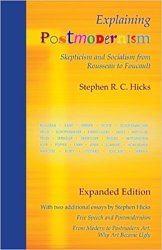Immanuel Kant said:
“Everything intuited in space or time, and therefore all objects of experience possible to us, are nothing but appearances, that is, mere representations, which in the manner in which they are represented, as extended beings, or as series of alterations, have no independent existence outside our thoughts.”
 For more on the meaning and implications of Kant’s philosophy for postmodernism, see Chapter Two of my Explaining Postmodernism: Skepticism from Rousseau to Foucault.
For more on the meaning and implications of Kant’s philosophy for postmodernism, see Chapter Two of my Explaining Postmodernism: Skepticism from Rousseau to Foucault.
Information about other editions and translations is available at this dedicated page.

You make the same error that Kant knew would be made by all who skim through the Critique and don’t think through it: You mistake Kant for Berkeley.
In Kant’s understanding, certainty is possible, and knowledge of objective reality is possible.
You think that the restriction of knowledge to empirical reality makes the knowledge merely subjective.
For you, objects encountered in space and time are objectively real – as they are for Kant, but for you, their shapes exist beyond experience: The shapes (of colors that you see) exist outside of experience *as shapes*, exactly as you see them.
For you, the shapes you see do not *correspond* to something real but unknown outside of experience (which is Kant’s position), but you believe that you have access to that which exists outside of experience, and know that it is a shape, just as you see it.
This proves that you don’t understand the transcendental aesthetic.
It also proves that you don’t understand special relativity, which already proves that there is no simultaneity outside of experience, because observers moving relative to one another will (even correcting for the time light takes to travel) perceive events to occur in different orders, and will perceive objects to have different shapes.
Hence the simultaneity of the parts of space, and of the parts of shapes, is not something that exists in the absence of an observer.
You can look up “Relativity of simultaneity” on Wikipedia to confirm this, or read a book.
Those shapes that you thought were really absolutely what exists in the absence of experience, actually exist only from the point of view of an observer, just like colors and tastes and, of course, pain.
Just like real pain differs from imaginary pain but doesn’t exist as pain outside of the mind, the shapes you see are real, but don’t exist as shapes outside of your mind (though, like pain, they correspond to something real but non-mental).
Three quick points in reply, R.
1. I agree that naive realism is false.
2. I agree that Kant is not a Berkeleyan.
3. Some quotations directly from Kant will help. Here are some: http://www.stephenhicks.org/2011/11/20/was-kant-really-that-skeptical/.
Thanks for your reply.
In response: Kant presented those statements (apart from the “scandal to philosophy”) as firm conclusions, not doubts. There is no skepticism involved.
The quotes themselves express certainty, not doubt.
1. “External objects (bodies) are merely appearances, hence also nothing other than a species of my representations.”
Now either you understand that simultaneity, and hence shape, exists only in experience (look up Relativity of simultaneity) and you agree with Kant that spatial things are representations only, or you don’t understand that.
To say that they are nothing other than representations does not mean that they don’t represent anything. They are representations of things which have really been encountered in experience, so they *do* represent something real.
You accuse Kant of skepticism. You accuse him of saying that spatial things are not representations of anything real. You replace “nothing other than … representations” with “representations of nothing real”.
2. “Your object is merely in your brain.”
Indeed, *your* object is precisely there.
*The* object, when those things which depend on the experience of an observer are removed, is not in any location at all.
You can misinterpret Kant and accuse him of being wrong and you’ll get away with it, but if you assert that location in space (or shape) remains in the absence of observers, you are saying that Einstein is wrong. That earns you 10 points on the famous “crackpot index”.
3. “If I remove the thinking subject, the whole corporeal world must at once vanish.”
If you disagree with this, you’re disagreeing with Einstein, because the corporeal world is spatial and its parts are simultaneous.
That simultaneity of the parts of space only exists from the point of view of an observer.
Without an observer, there is no space. That is what Kant said and it is universally accepted modern science.
Kant *concluded* it. He *deduced* it. He reached the conclusion through correct reasoning.
You call that mere skepticism.
Einstein reached the same conclusion through different reasoning.
Why don’t you call Einstein a postmodern anti-reason skeptic as well?